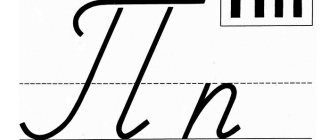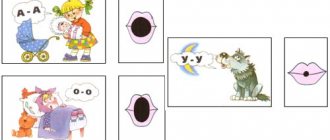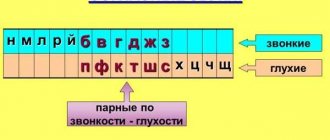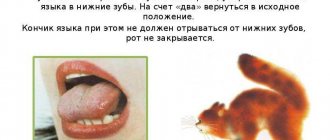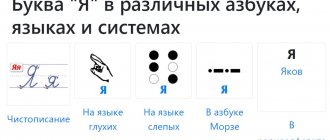How to teach children to distinguish between hard and soft consonants
The very first thing you need to teach your child: consonant sounds can be hard and soft, but not letters.
Typical mistake: Children confuse sounds and letters. We remember that a sound sounds, and a letter is an icon, it is written. A letter cannot be hard or soft; only a consonant sound can be hard or soft in pronunciation.
Sometimes children can easily learn to distinguish soft and hard sounds by ear. But it happens that this is difficult, and in this case signs will come to the rescue by which you can distinguish hard sounds from soft ones.
Examples of tasks for children
Voiceless or voiced:
- A simple and vivid way that helps you understand the difference is to put your palm to your throat when pronouncing. Go through all the consonants, let the child discover which letter vibrates and which does not give sensations.
- Choose pictures that resemble ringing and deafness. For example: bell and ear. Say different words of one or two syllables, and if the child hears a ringing sound, he should show a picture with a bell. Then play the same way with a dull sound. When the child gets comfortable with simple words, take longer ones.
Hard or soft:
- Offer to take one letter and sing syllables with vowels that give hardness. Let the child feel the firmness in his voice. Then, with the same letter, sing syllables with vowels that give softness.
- Name the syllable and throw the ball to the child. If it's hard, you should catch it. If it's soft, push it away.
- Make a chain of words. For example, chair-horse-money-guitar...
General tasks:
- Create your own table with colorful images and hang it in a prominent place. When a child chooses a picture or color himself, he becomes more involved in the topic and remembers it faster.
- Offer to name a word that has both a voiced and a voiceless word. Or deaf and, at the same time, hard.
Distinctive features of soft and hard sounds
What sound comes after a consonant:
- If after a consonant there is a vowel a, o, u, e, s, then the consonant is hard.
- If after a consonant there is a vowel and, e, yu, i, then the consonant is soft.
Practice with examples: In the words “mother” and “nora” the consonants are hard, because they are followed by “a” and “o”. In the words “fly” and “nanny” the consonants are soft because they are followed by “e”, “i”, “ya”.
- If another consonant sounds after a consonant, then the first consonant will be hard.
- There are sounds that can only be hard and sounds that can only be soft, no matter what sound is heard or what letter is written after them.
Always hard sounds - zh, sh, ts. Always soft - th, h, shch. A common way to learn these sounds is a simple technique: we write the letters that convey these sounds on a line, and emphasize “th, ch, sch.” The underscore symbolizes the cushion on which the soft sounds sit. The pad is soft, which means the sounds are soft.
Soft sign and hard sign
- If there is a consonant at the end of a word and the letter “b” after it, then the consonant is soft.
This rule is easy to apply if the child sees the written word, but it will not help if the child performs the task by ear.
Movement of the tongue when pronouncing soft and hard sounds
When pronouncing a soft sound, the tongue moves slightly forward, approaching (or touching) the palate with its middle. When pronouncing hard sounds, the tongue does not move forward.
PRONUNCIATION CHECK
Parents who hear their child every day get used to his babbling and often do not notice speech therapy problems. Sometimes speech defects are indicated by kindergarten teachers, elementary school teachers, or simply people who heard the child speak for the first time. There are two ways to identify violations of the pronunciation of the sound Ш at home: 1. observation of the child. This method is time-consuming and requires attentiveness from parents; 2. exercises for pronunciation of the sound Ш. Simple tasks will help mothers and fathers understand whether their child has problems with pronunciation. Speech therapists recommend the following exercises to diagnose the problem: - “Snake” - the baby should imitate the hissing of a snake (sh-sh-sh-sh-sh); - “Repeat” - the baby is asked to repeat syllables containing the sound Ш. You need to start with syllables that consist of two letters, for example, “she”, “shu”, “osh”, “yash”, etc. Then you can complicate the task and offer the child three-letter syllables, for example, “osho”, “asha”, “ishi”, “usho”, etc. The most difficult to pronounce are syllables with consonants, for example, “rsha”, “psho”, “shki”, etc. When inviting your child to pronounce syllables, an adult must pronounce them clearly and with correct articulation; - “Name the object” - adults need to prepare in advance an image of objects whose names contain the sound Ш. For this exercise, you can use children’s lotto cards, print out the necessary pictures from the Internet, or simply show them on the computer. The main thing is that the baby knows the name of all the objects, for example, a cone, a cat, a mouse, a hat, a hut, a fur coat, a ball, etc.; - tongue twisters starting with the letter Ш - the most difficult task, the implementation of which requires good articulation. The following tongue twisters are suitable for children: “Sashka has cones and checkers in his pocket”, “A hat and a fur coat - here is our Mishutka”, “Six little mice are rustling in the reeds”.
Examples of interesting tasks for developing the skill of distinguishing between soft and hard consonants
A picture or simply a list of thematic words is shown, and the task is given to choose words with soft or hard consonants. For example:
Consonant, voiceless, oral, labialized, sibilant.
Articulation is normal when spoken in isolation.
The lips are labialized and extended forward. The teeth are compressed or brought together so that the distance between the incisors (teeth) does not exceed 2-3 mm. The anterior edge of the tongue is raised and comes into contact with the palate behind the alveoli, leaving a narrow flat gap in the middle; the lateral edges are adjacent to the upper molars. The entire tongue is shaped like a cup. There is a groove in the middle. Vocal cord position: open. You can see the position of the lips, the distance between the incisors; mouth-opening tongue position. You can feel a wide, warm, strong air stream directed obliquely downwards.
Staging. Analysis of the word up to the syllable KARANDASH-KA-RAN-DASH-ASH. We compare the sounds [A] and [Ш] on the hands and on the tongue without a voice. The child’s hand is on the chest: when pronouncing the sound [Ш], there is no vibration, the air stream is strong. Based on the sound [S] mechanically (probe, finger, spatula): “Say S,” raise the tip of the tongue with the probe, but do not come into contact with the alveoli; You can, as an exception, push your tongue back with a probe - you get a soft Sh. Gesture display. Speech motor rhythm. Articulation profile.
Types of incorrect pronunciation . "Dental sigmatism." W=T The tip of the tongue is adjacent to either the alveoli or the incisors. On an auditory-visual basis, take the word and show the nature of the air stream (the stream has become jerky). Lateral "sigmatism". The lateral edges are lowered, the tip of the tongue closes the gap. 1 Check the sound [C], if everything is corrected well. 2 Preparatory exercises (can be used for setting): Give the tongue a spoon shape and lift it to the lip (outside), and blow. Move the tongue behind the teeth towards the alveoli and labialize the lips. "Whistling sigmatism." Ш=С. The tip of the tongue is pressed against the lower incisors. It is necessary to reinstall, and only the upper Sh. “Interdental sigmatism.” "Buccal Sh." Ш=Ш tongue is passive. We set the sound again. "Voicing". W=F. Vocal cords are closed. We eliminate it on an auditory-visual basis; there should be no vibration. “Labiodental Sh.” W=F. Passive language. Let's reinstall it. Insufficiently labial lips. The distance between the incisors has been increased. Tongue strongly retracted. The velum is lowered. Just exhale.
Automation of sound [Ш]. Correctly pronounce the sound [Ш] in syllables. SHA, SHO, SHU, SHI, SHE, SHA-SHO, SHA-SHU, SHA-SHI, SHA-SHE, SHO-SHA, SHO-SHU, SHO-SHI, SHO-SHE, SHU-SHA, SHU-SHO, SHU-SHI, SHU-SHE. We highlight the stressed syllables SHA SHA, SHA SHASHA, , SHA SHA , SHA SHA SHA, SHASHA SHA . We pronounce in the words BALLS, HAT, SCARF, FUR FUR COAT, NOISE, SHURA, JOKE, CHECKER, Naughty, JACKAL, SEAM, WHISPER, TIRE, AWL . We automate the sound [Ш] between the vowel sounds ASHA, OSHO, USHU, YSHI, ASHO, USHA, OSHA, OSHU, ASHU, Automation of the sound [Ш] in the reverse syllable. ASH, OSH, USH, YSH, YASH, ESH, YUSH, ISH. In the reverse syllable in the words YOUR, OUR, SHOWER, TUSH, MOUSE, BUCKET, RUSH, LILY OF THE LILY, BABY. In the reverse syllable in the sentences SASHA GIVE A RED PENCIL, MASHA GIVE A BLUE PENCIL, MISHA GIVE A YELLOW PENCIL, DASHA GIVE A GREEN PENCIL. Correctly pronounce the sound in combination with the consonant SHVO, SHVA, SHLO, SHMO, SHNO, SHPO, SHRO, SHVA, SHKA, SHLA, SHMA, SHNA, SHRA, SHPA, SHVU, SHKU, SHLU, SHMU, SHNU, SHPU. We pronounce in the words CABINET, BOX, SCHOOL, HOSE, HAT, SLEEP, THING, CRUMBLE, REEL, HALF, FROG, GRANDMOTHER, GRANDFATHER, CAT, DUMMY, MOUSE. We pronounce the sound [Ш] in the sentences SHURA HAS A FUR COAT, SHURA HAS A HAT. SHURA AND PASHA GO TO SCHOOL.
Voiced and voiceless consonants
There are 11 pairs of voiced/voiceless consonants in the Russian language. The phonetic difference between voiced and voiceless consonants lies in the tension of the vocal cords. Voiceless sounds are pronounced with the help of noise, without straining the ligaments. Voiced sounds are pronounced by voice and are caused by vibration of the vocal cords, because air comes out of the larynx noisily.
Table of voiced and unvoiced sounds
Mnemonic device for memorizing dull sounds: Learn the phrase: “Styopka, do you want a cheek? - Fi! All consonant sounds here are unvoiced.
STEPS OF PRODUCING DIFFICULTLY PRONUNCIABLE SOUNDS
To quickly and effectively produce the sound Ш, classes with a child should consist of the following stages: - articulatory gymnastics. In the first lesson, you need to show the baby which organs are involved in the speech apparatus. You need to sit him in front of a mirror and let him carefully examine his tongue, lips, palate and cheeks. In order for the articulatory apparatus to be trained and ready to perform exercises, you need to do a special warm-up: with a tense tongue you need to slowly move it across the palate, then move it over your lips and teeth, and then stick your tongue out as far as possible and smile; - staging speech breathing - the sound Ш must be pronounced as you exhale, while you need to exhale a certain amount of air. Games with inflating balloons, soap bubbles, using whistles, etc. will help teach you to control the amount of air exhaled; - setting the sound Ш - performing simple fun exercises that the child will like and help him pronounce the hissing sound; - consolidation of the assigned sound - reading and memorizing nursery rhymes and tongue twisters based on the assigned sound.
Replacing F with W
The sound [ts] is not hissing. And the other two are called exactly that. In a weak position (at the end of a word or before voiceless consonants), the sound [zh] is replaced by [w]:
- get married [zamush];
- already [ush];
- unbearable [nefterpesh];
- spoon [loshka];
- horns [rosk'i].
Dictation text on this topic, which will help you carry out interesting training work on this spelling:
This always happens when consonant, voiced, and hard sounds in a weak position are replaced by the same ones, only unvoiced.
The Golitsyn sisters got married. They can't stand it anymore. And the dowry is ready: spoons, mugs, pillows, boots, tubs, bowls, cups, ladle. And then a droshky appeared on the path; Seryozhka, Alyoshka, Proshka and Olezhka, the sisters’ suitors, were riding there. Here the fairy tale ends, and they lived happily ever after.
When to place b after Ж and Ш
Due to the fact that the above consonants are always hard, a soft sign to indicate softness is never used with them. However, there are times when you can find it after the letters Ж and Ш:
- mouse;
- lie;
- shiver;
- brooch;
- nonsense;
- entirely;
- don't touch;
- you hear.
These examples illustrate the rule of using a soft sign to indicate the grammatical form of words:
- 3rd cl. nouns: quiet, whim.
- Adverb: backhand.
- Verbs: go, put it down.
We use the following suggestions for training:
It’s just a lie that the mouse is scary: don’t touch it when you walk by, and it won’t touch it either.
If the house is quiet, and you don’t scream, don’t jump, don’t make fun, there’s some kind of catch here, you won’t understand right away. What are you doing there, and you yourself are silent?
